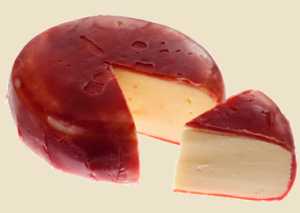The ingredients for making cheese haven’t changed since people discovered how to save summer gluts of milk to see them through the lean winter times.

Waxing protects the cheese from evaporation and mould growth etc whilst it matures.
Rennet
In cheesemaking, it is not always convenient to have coagulation at a very acid level; some cheeses require coagulation earlier. This is where rennet comes in.
Rennet is a curdling agent, which acts on the milk protein casein, causing separation of the milk into solid curds and liquid whey.
Traditionally it was derived from a calf’s stomach, but now vegetarian rennet is also available, although more of the latter is required.
General rate of usage is 4 drops per 5 litres of milk for soft cheeses and 4 drops per 1 litre for hard cheeses, but this varies depending on the cheese.
Some soft cheeses, for example, need a very small amount, with a long setting period, otherwise they go rubbery.
Also, the more acidic the milk, and the more starter has been used, the shorter the setting time. Coagulation also takes place more quickly at a warm temperature, such as 30° C.
Salt
Salt enhances the flavour of a cheese, and acts as a preservative. It also helps to drain and firm the cheese. It is sprinkled on to the curds before they are put into the mould. The amounts vary, depending on the cheese, but a general guideline is as follows:
- Dry salting : 2% per kilo of curds, ie, 20g salt per kilogram of curd.
- 20% brine solution : 200ml (13 level tablespoons) salt per litre of water.
Herbs
Some cheeses may have chopped herbs such as parsley or sage added for extra taste, and depending on the recipe. Fresh or dried herbs can be used, and are normally added to the curd at salting. Finished soft cheeses are sometimes rolled in herbs or crushed black peppercorns. Some pressed cheeses may be marinated in beer or cider.
Colouring
Annatto, a substance from the seeds of the South American plant Bixa orellana, is sometimes used to colour cheeses, but home cheese makers generally do not need it. It is available from specialist suppliers.
The amount used depends on the degree of colour required, and usually ranges between 5-15ml per 50 litres of milk. The colour becomes more apparent as the curds form. It is added after the starter but before the rennet.
Wax
Pressed cheeses can be bandaged or coated with wax, and cheese wax is available in different colours from specialist suppliers.
Acidity
For example, when making a Cheshire cheese the acidity or level of lactic acid in the milk should be about 0.20% at renneting.
Perfectly good cheeses can be made without as detailed a technique as this, but the ability to test the acidity is important to the commercial producer if a reasonably standard product is to be achieved.
A traditional way of testing acidity is to use a Lloyd’s acid meter. Dairying pH sticks for testing acidity are also available, as well as electronic pH gauges.
With the preparations and equipment to hand, the next stage is to start making the cheese. That’s where the fun begins! Here’s just one example next:
Next In Making Cheese at Home
Next we look at Making Cheddar Cheese at Home >>
© Copyright Katie Thear 2006 Author of Cheesemaking and Dairying
Making Cheese Articles & Information
- Cheese Making Basic Guide, Tutorial – Home Made Cheese
- Cheese Making Equipment for Making Cheese at Home
- Milk & Starter Cultures – Ingredients for Making Cheese
- Making Cheddar Cheese at Home
- How to Make Your Own Cottage / Curd Cheese at Home


